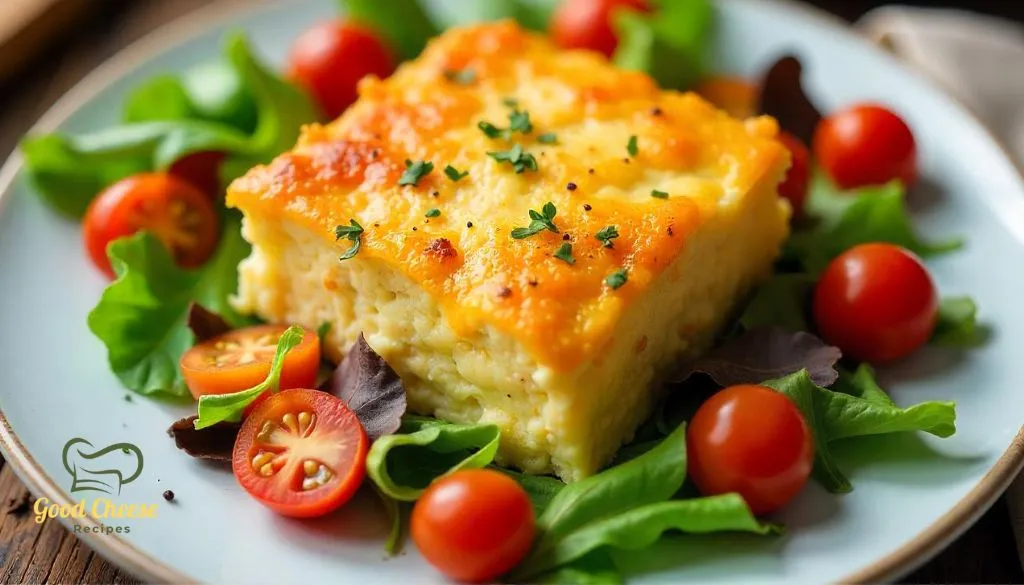If you’re looking for a healthy, protein-packed, and easy-to-make dish, this Cottage Cheese Casserole is the perfect recipe for you! Whether you’re meal prepping for the week, looking for a nutritious breakfast, or craving a comforting dinner, this casserole ticks all the boxes.
Cottage cheese is a nutrient-dense ingredient that adds a creamy texture, boosts protein intake, and keeps the casserole light yet satisfying. this recipe is versatile—you can customize it to fit different diets, whether you prefer low-carb, keto, or vegetarian options.
Table of Contents
Why You’ll Love This Cottage Cheese Casserole
High in Protein & Low in Carbs – Great for Meal Prep and Healthy Eating
This cottage cheese casserole is packed with high-quality protein from cottage cheese and eggs, making it an excellent choice for anyone looking to build muscle, stay full longer, or maintain a balanced diet. With low carbohydrates, it fits well into low-carb and keto meal plans, making it a guilt-free indulgence. Plus, it’s a fantastic option for meal prep—you can make a batch ahead of time and enjoy it throughout the week.
Easy & Quick to Make – Requires Simple Ingredients and Minimal Effort
One of the best things about this casserole is how simple it is to prepare. With just a handful of basic ingredients like cottage cheese, eggs, and cheese, you can whip up a delicious meal in no time. The entire process—mixing, baking, and serving—takes less than an hour, making it perfect for busy weekdays or lazy weekend brunches. No complicated cooking techniques are required!
Versatile & Customizable – Can Be Made Vegetarian, Keto-Friendly, or Extra Cheesy
This casserole is incredibly adaptable to suit different tastes and dietary needs:
✔️ Keto-Friendly – Stick to full-fat cheeses and avoid breadcrumbs for a perfect low-carb dish.
✔️ Vegetarian Option – Add spinach, mushrooms, bell peppers, or zucchini for extra nutrition and flavor.
✔️ Extra Cheesy – Love a rich, cheesy bite? Mix in cheddar, parmesan, or mozzarella for the ultimate cheesy casserole.
✔️ Protein Boost – For meat lovers, try adding shredded chicken, turkey, or ham to make it even more filling.
No matter how you customize it, this cottage cheese casserole is guaranteed to be a crowd-pleaser!
Ingredients You’ll Need
To make the best cottage cheese casserole, you only need a few simple, wholesome ingredients that come together beautifully. Here’s what you’ll need:
🧀 Cottage Cheese – The Star Ingredient for a Creamy Texture
Cottage cheese is the foundation of this casserole, providing a creamy texture and high protein content. Unlike other cheeses, it keeps the dish light yet satisfying, making it a great option for healthy eating. Opt for full-fat cottage cheese for extra richness or low-fat for a lighter version.
🥚 Eggs – Helps Bind the Casserole Together
Eggs act as the binding agent, ensuring the casserole holds its shape while baking. They also add structure, moisture, and extra protein, making this dish even more filling.
🧀 Cheeses (Cheddar, Parmesan, or Mozzarella) – Adds Flavor and Richness
Adding shredded cheddar, parmesan, or mozzarella takes this casserole to the next level.
- Cheddar – Sharp and tangy, perfect for a bold cheesy flavor.
- Parmesan – Nutty and slightly salty, adding depth and umami.
- Mozzarella – Melts beautifully, creating a gooey, stretchy texture.
Feel free to mix and match your favorites!
🥄 Sour Cream or Greek Yogurt – Enhances Creaminess
Adding sour cream or Greek yogurt gives this casserole an extra creamy consistency while boosting the protein content. Greek yogurt is a great alternative if you’re looking for a healthier, probiotic-rich option.
🌿 Seasonings & Add-ins – Boost the Flavor
While the basic recipe is delicious on its own, you can enhance the taste with seasonings and mix-ins:
✔️ Garlic Powder & Onion Powder – Adds warmth and depth of flavor.
✔️ Spinach or Kale – For a nutritious, vegetarian-friendly boost.
✔️ Bell Peppers & Mushrooms – Adds sweetness and a bit of texture.
✔️ Diced Ham or Cooked Turkey – If you want an extra protein punch.
By customizing your ingredients, you can create a cottage cheese casserole that fits your taste and dietary needs perfectly!
Step-by-Step Guide to Making Cottage Cheese Casserole
1. Preheat & Prepare – Set the Oven Temperature and Grease the Baking Dish
Start by preheating your oven to 350°F (175°C). This ensures the casserole cooks evenly and reaches the perfect texture. While the oven is heating up, grease your baking dish—this will help prevent sticking and make serving much easier. You can use non-stick cooking spray, a little butter, or a thin layer of olive oil.
If you’re using a 9×13-inch baking dish, this recipe should fit perfectly. However, if you’re using a smaller or larger dish, just adjust the cooking time accordingly (a smaller dish may require less time, and a larger one may need a bit more).
2. Mix the Ingredients – Combine Cottage Cheese, Eggs, Shredded Cheese, and Seasonings
In a large bowl, combine the cottage cheese, eggs, and your choice of shredded cheese (cheddar, mozzarella, or parmesan). Stir them together until well incorporated. The eggs will help bind everything together, while the cheese will melt and create a rich, creamy texture.
Next, add your seasonings. I recommend garlic powder, onion powder, salt, and black pepper for a simple, savory base. If you’re adding vegetables (like spinach, bell peppers, or mushrooms), this is the time to stir them in as well. For added depth, you can throw in a pinch of nutmeg or dried herbs like thyme or oregano. Mix everything until the ingredients are evenly distributed.

3. Bake to Perfection – Pour into a Baking Dish and Bake Until Golden Brown
Once your mixture is ready, pour it into the prepared baking dish. Use a spatula to spread it out evenly, ensuring the top is smooth. Place the dish in the preheated oven and bake for 30-40 minutes, or until the casserole is golden brown on top and the center is firm.
To check for doneness, insert a toothpick or knife into the center. Your casserole is ready if it comes out clean (without liquid egg). The top should be slightly crispy, while the interior remains soft and creamy.
4. Serve & Enjoy – Let It Cool Slightly Before Serving
Once the casserole is baked to perfection, remove it from the oven and let it cool for about 5-10 minutes. This allows the casserole to set, making it easier to cut into neat portions.
After it’s had time to rest, slice it up and serve! It’s great on its own or paired with a fresh salad or roasted veggies. Whether you enjoy it as a savory breakfast, a hearty lunch, or a filling dinner, you’ll love the comforting flavors and creamy texture.
Variations & Serving Suggestions
1. Make it Keto-Friendly – Use Full-Fat Cheese and Avoid Breadcrumbs
If you’re following a keto diet, this casserole is naturally a great option, but you can make it even more keto-friendly by making a few simple swaps. Start by using full-fat cheeses like cheddar, mozzarella, or cream cheese. These provide more healthy fats and fewer carbs than their low-fat counterparts, which aligns perfectly with the goals of a keto diet.
Additionally, avoid adding breadcrumbs or any carb-heavy fillers. Some traditional casseroles use breadcrumbs to create a crispy top, but for a keto twist, you can skip this entirely or replace breadcrumbs with almond flour or crushed pork rinds for that same crunchy texture without the carbs.
2. Add More Protein – Include Diced Chicken, Turkey, or Ham
Looking to pack even more protein into your casserole? Add some diced chicken, turkey, or ham. These lean meats not only enhance the flavor but also turn your casserole into a more filling, well-rounded meal. You can either use leftover roasted chicken or quickly sauté some diced turkey or ham and fold it into the mix before baking.
For a high-protein, low-carb meal, try combining cottage cheese with these meats for a satisfying dish that will fuel your body throughout the day. The protein boost is great for those who are looking to build muscle, manage hunger, or stick to a high-protein diet.
3. Vegetarian Twist – Mix in Spinach, Mushrooms, or Zucchini
For those who prefer a vegetarian version or just want to add more vegetables, you can easily make this casserole both nutritious and delicious with some green goodness. Stir in fresh ingredients like spinach, mushrooms, or zucchini to boost the nutrient content and add more flavor.
- Spinach – High in vitamins and minerals, spinach adds a mild, earthy flavor that complements the richness of the cottage cheese.
- Mushrooms – These provide a savory umami flavor and add a hearty texture to the dish.
- Zucchini – With a mild flavor and plenty of water content, zucchini adds moisture and lightness.
You can sauté the veggies beforehand to release any excess moisture or add them fresh into the casserole mix for a more subtle flavor. This is a great option for a vegetarian meal or if you’re just looking to boost your vegetable intake.
4. Best Pairings – Serve with a Fresh Salad or Roasted Vegetables
While the casserole itself is hearty and satisfying, pairing it with a fresh salad or roasted vegetables takes it to the next level. The crispiness and lightness of a fresh salad contrast nicely with the creamy richness of the casserole. You can make a simple salad with mixed greens, tomatoes, and a light vinaigrette dressing.
Alternatively, roasted vegetables like carrots, brussels sprouts, or broccoli work wonderfully alongside the casserole, adding more flavor, fiber, and nutrients to your meal. These side dishes balance the casserole’s richness and help create a well-rounded meal that’s perfect for any time of day.

Storage & Reheating Tips
Refrigeration and Storage – Keep Your Cottage Cheese Casserole Fresh
To enjoy your cottage cheese casserole for days after making it, proper storage is key. Here’s how you can keep it fresh:
Storing Leftovers
Once your casserole has cooled to room temperature, store leftovers in an airtight container. This helps preserve the flavor and texture, preventing it from drying out or absorbing other smells from your fridge.
You can also divide the casserole into smaller portions for easier reheating later, especially if you prefer grabbing a quick meal on busy days.
How Long Does it Last?
When stored properly in the fridge, your cottage cheese casserole will stay fresh for up to 4 days. After this time, it may begin to lose its texture or flavor, so it’s best to enjoy it within this window.
Freezing for Longer Storage
If you’d like to keep your casserole for a longer period, you can freeze it! After cooling, wrap the casserole tightly with plastic wrap or aluminum foil, then place it in an airtight container or freezer-safe bag. It can be frozen for up to 2-3 months.
Freezing Option – Freeze Individual Portions for Easy Meal Prep
Freezing your cottage cheese casserole is a great way to preserve leftovers for longer and make meal prep a breeze. Here’s how to freeze and store it effectively:
1. Cool Completely Before Freezing
Before freezing your casserole, allow it to cool completely at room temperature. This helps to prevent condensation inside the container, which could lead to freezer burn or sogginess.
2. Freeze in Individual Portions
For convenient meal prep, consider freezing your casserole in individual portions. This way, you can grab just the right amount when you’re ready to eat without needing to thaw the entire casserole. You can use small, freezer-safe containers or even freezer bags. Just be sure to portion out the casserole into servings that make sense for your meals, whether it’s for lunch or dinner.
To keep it organized, label the portions with the date and any reheating instructions (for example, “Reheat at 350°F for 20 minutes”).
3. Wrap for Extra Protection
If you’re using freezer bags, wrap the casserole tightly in plastic wrap or aluminum foil before placing it inside the bag. This adds an extra layer of protection against freezer burn and keeps the flavors intact.
4. How Long Can You Freeze It?
You can freeze individual portions of cottage cheese casserole for up to 2-3 months. After this time, while it will still be safe to eat, the texture and flavor may start to degrade. For the best taste and texture, try to use it within this time frame.
5. Reheating from Frozen
To reheat frozen portions, you can either let them thaw in the fridge overnight or go straight from the freezer to the oven. Preheat your oven to 350°F (175°C) and bake until heated through (about 20-30 minutes, depending on the size of the portion). You can also microwave individual servings for a quicker option, but be sure to cover them to keep moisture in.
Reheating – Warm in the Oven or Microwave for Best Texture
Whether you’re enjoying your cottage cheese casserole from the fridge or freezer, reheating it correctly ensures it stays as delicious and creamy as the first time you made it. Here are some tips to help you reheat your casserole to perfection:
1. Reheating from the Fridge
If you’ve stored your casserole in the fridge and it’s cooled down, reheat it in the oven for the best texture. The oven helps to retain moisture while giving the top a nice golden-brown finish.
- Preheat your oven to 350°F (175°C).
- Place the casserole in an oven-safe dish and cover with foil to prevent it from drying out.
- Bake for about 15-20 minutes or until heated through. You can uncover it for the last few minutes to allow the top to get crispy again.
- For individual servings, you can microwave for 2-3 minutes, checking and stirring if needed to ensure even heating.
2. Reheating from Frozen
If you’ve frozen your casserole, the best method is to thaw it overnight in the fridge before reheating. However, you can also reheat it directly from the freezer if you’re short on time:
- Oven: Preheat your oven to 350°F (175°C). Cover the casserole with foil and bake for about 30-40 minutes until heated through. If it’s a larger portion, it might take a bit longer.
- Microwave: Place your casserole in a microwave-safe container, and microwave on high for 3-4 minutes, stirring halfway through to ensure even heating. If you’re reheating individual portions, you can microwave them for 1-2 minutes at a time until hot.
3. Tips for Maintaining the Best Texture
When reheating, you want to ensure that your casserole remains creamy and does not dry out. Here are a few tips:
- Cover with foil while baking to keep moisture in.
- Add a small splash of milk or cream before reheating if it seems too thick.
- For a crispier top, uncover the casserole during the last few minutes of baking.
- For microwave reheating, stir the casserole halfway through to make sure it’s heated evenly.
4. Reheating Individual Portions
For quick meals, reheat individual portions in the microwave, making it easy to enjoy your casserole without waiting for the whole dish to heat up. Just be sure to check the temperature by stirring and testing it, as the microwave can sometimes heat unevenly.
Conclusion
In conclusion, cottage cheese casserole is an incredibly versatile and delicious dish that can easily become a staple in your meal rotation. Whether you’re looking for a high-protein, low-carb meal, a quick dinner option, or something that can be customized to fit your dietary preferences, this casserole has it all.
With its creamy texture, the ability to add a variety of ingredients, and the option to make it keto-friendly or even vegetarian, there’s no limit to how you can enjoy this dish. Plus, it’s perfect for meal prep, whether you make it ahead and store it in the fridge for a few days or freeze individual portions for easy meals later.
Reheating your casserole is a breeze, ensuring you can enjoy it just as much the second time around. So, gather your ingredients, follow our step-by-step guide, and savor every bite of your delicious cottage cheese casserole!
Don’t forget to experiment with different add-ins and toppings to make it uniquely your own. Whether you serve it with a fresh salad, a side of roasted vegetables, or enjoy it solo, this casserole will become a go-to comfort food in your kitchen!

